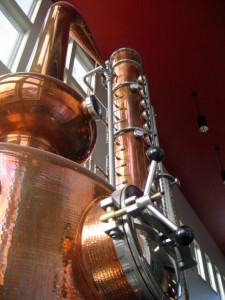
Editor’s Note: This is a guest post, written by Michael Ammermuller a New York Cork Report reader and a western New York-based writer with an interest in beer, wine and spirits.
Driving through the Finger Lakes in the early days of summer, focusing on the smell in the air is probably the last thing one wants to do; freshly fertilized ground is not a very pleasant aroma. However, the human nose is much more discerning than a lot of us may appreciate; in fact, humans are able to distinguish dilutions of less than one part per several billion parts of air. Frankly, I’m not sure exactly what that ratio means but I do know that if you monitor the air around Seneca Lake, you may pick up something else: Part de Anges.
For those who do not speak French, this is what English-speaking distillers refer to as “the angel’s share.” As a distillate ages in an oak barrel, some is lost to evaporation and the aromas of the aging spirit fill the air. At large distilleries in Kentucky (for example) this smell acts as the unofficial greeting to the distillery.
On my first visit to Finger Lakes Distilling on the southeastern corner of Seneca Lake, I was expecting this fragrant “welcoming committee” but I was greeted by two beautiful sights instead: a hill-side view of the lake and the shimming copper of the still. To be fair, large distilleries have multiple barrel-storage warehouses (a.k.a. “rick houses”), each with hundreds of barrels of spirits while Finger Lakes Distilling has one warehouse storing only several dozen barrels. So by volume the angel’s share wouldn’t be as large — hence not as noticeable. However, once inside the tasting room I was welcomed by these ethereal aromas — and by the extremely helpful and knowledgeable staff too.
For Finger Lakes Distilling, the angels are not the only one’s demanding their share. Since it opened its doors in 2009, this craft distillery has grown in popularity; in fact, they’ve outgrown their first still. Within the last year, they’ve added a 900-gallon continuous still to handle the increased demand — specifically for their whiskies.
According to Finger Lakes Distilling president Brian McKenzie, they’ll basically be able to quadruple their production based on the larger volume and the efficiency gains associated with the new still. Since their products are now available in several markets outside of New York State (e.g. Massachusetts, Illinois) and hope to export their products outside of the U.S., their new still will not be sitting idle.
“Be Still, My Beating Heart”
In general, most spirits are either batch or continuously distilled. Different methods require different still designs: pot still for the former, column still for the latter. Column (continuous) stills are much more efficient for alcohol distillation. As the name suggests, alcohol is continuously distilled as the mash/beer (the post-fermentation product) descends against rising steam through a series of plates inside the column, increasing the surface area from which the alcohol evaporates.
The pot still, which has only one heat source, distills in batches and has a comparatively lower alcohol output than the column still. However, the pot still is favored by some distillers as more of the fragrant chemical compounds (congeners) are captured and preserved during distillation — or so it is claimed.

As the original still for Finger Lakes Distilling has pot and column still components (which is not an uncommon still design for smaller distilleries), I asked if some of the congeners would be stripped away in this new continuous-only still design.
Brian said not to worry.
“Our new still gives us more flexibility,” said Brian, as they can determine how many plates the wash passes through, giving them more control over the final distillate. The head distiller, Thomas Earl McKenzie (no relation to Brian), claims that the whiskies coming off their new still have even richer aromas than those that came from the original still. This bodes well for the whiskies.
More than Whiskies
The whiskies pay the bills for Finger Lakes Distilling. So while the whiskies are quite good, most notably the Rye and Pure Pot Still (i.e. Irish-style), Finger Lakes Distilling remains a craft distillery at heart and continues to use their original still for other products, including vodkas, gins, and a variety of other lesser-known distillates (e.g. grappa, eaux-de-vie) – plus maybe a few new things.
“I’d love to make an amaro,” said Brian, referring to the supremely bitter Italian liqueur.
Now, I make it a point to love the spirits that no one else seems to — the underdogs (if you will) in the world of distilled spirits — so I was extremely pleased to hear Brian say this. I am an advocate for these superb and interesting spirits in a country that often overlooks them. Brian agrees that drinking these spirits is “largely a European thing.” Historically, these spirits were enjoyed as aperitifs (before-dinner drinks) or digestifs (after-dinner drinks) while the trend for drinking these spirits in the U.S. today is largely limited to ingredients in exotic cocktails.
While Finger Lakes Distilling is upgrading their website to include cocktail recipes for their line of products, I’ll take this opportunity to suggest that everyone should first try their grappa and Pear Brandy in their pure and unadulterated forms; their essences are unique and deserve their own moment.
While most people refuse to try grappa, since it can be musty and have “gasoline-like” aromas, I say the finish is what makes grappa so fantastic. Those produced by Finger Lakes Distilling leave lingering flavors that are anything but musty or “gasoline-like.” The grappas (one made with local riesling grapes, another with local gewurztraminer grapes) are rich in the aromas of their respective varieties: apple and honey for the riesling, spice and exotic fruits for the gewurztraminer.
The Pear Brandy, an eau-de-vie, is made from the entire pear (not just the juice) and has wonderful aromas of ripe pear and honey — it’s a pleasure just to nose the glass without even taking a sip. As it is unaged, it has some heat on it (from the alcohol) but the finish is long and the taste of pear lingers too; this is my favorite Finger Lakes Distilling product.
While Finger Lakes Distilling does make an apple brandy (“apple jack”) with apples from Red Jacket Orchards in Geneva, every distilled gallon is used in their Maplejack Liqueur. It’s dissapointing that an apple brandy isn’t available; tasting the Maplejack reveals that their apple brandy would be quite delicious on its own. However, this is a “good problem” for Finger Lakes Distilling — demand for the Maplejack Liqueur is too high to justify bottling the apple brandy as a stand-alone product.
Ambassadors of Distillation
With the apple brandy unavailable, I find solace knowing that there are plans to release a single-malt whisky. I was able to get a whiff (it’s been aged five years), and it smells fantastic. While the single-malt may only be a limited release, and an amaro may not technically be in the works (just yet), this is what makes Finger Lakes Distilling and other craft distillers so wonderful — they can take some risks with new and exciting products.
Brian was also involved with the efforts to pass the Farm Distillery Law in New York State (which gave greater market access in New York to small distilleries), therefore it’s no surprise that he is continuing to advocate for craft distilleries — specifically, lobbying for a reduction in both state and federal taxes on them. Currently, small craft distilleries pay the same rates as large distilleries — an inherently unfair burden. By reducing this tax burden, Finger Lakes Distilling and other craft distilleries will be able to continue their “smart” growth — investing in expansion and growing within their communities.
Thanks to FLD, the air around Seneca Lake is becoming a richer mix of scents, with grain and grape distillates softening the traditional summer musk. Their growing popularity and recent expansion herald a rich future for this lively craft industry in New York State.

